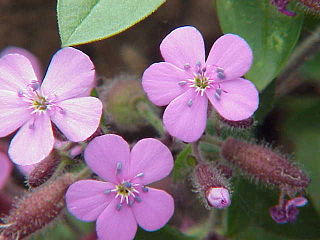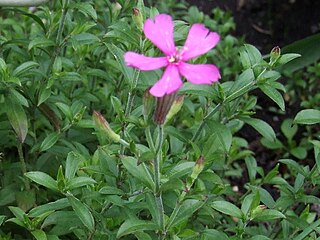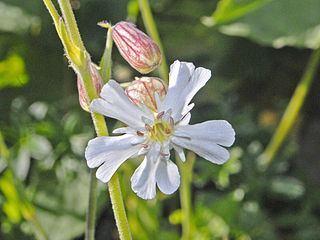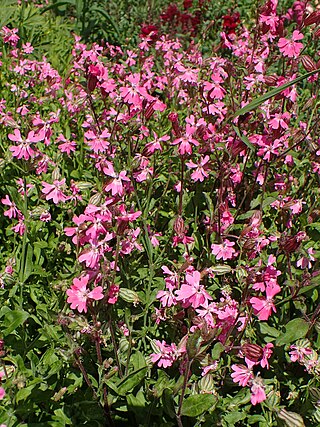
Silene is a genus of flowering plants in the family Caryophyllaceae. Containing nearly 900 species, it is the largest genus in the family. Common names include campion and catchfly. Many Silene species are widely distributed, particularly in the northern hemisphere.

Saponaria is a genus of flowering plants in the family Caryophyllaceae, native to Asia and Europe, and are commonly known as soapworts. They are herbaceous perennials and annuals, some with woody bases. The flowers are abundant, five-petalled and usually in shades of pink or white. The genus is closely related to the genus Silene, being distinguished from these by having only two styles in the flower. It is also related to Gypsophila, but its calyx is cylindrical rather than bell-shaped.

Silene chalcedonica, the Maltese-cross or scarlet lychnis, is a species of flowering plant in the family Caryophyllaceae, native to Eurasia. Other common names include flower of Bristol, Jerusalem cross and nonesuch.

Silene virginica, the fire pink, is a wildflower in the pink family, Caryophyllaceae. It is known for its distinct brilliant red flowers. Fire pink begins blooming in late spring and continuing throughout the summer. It is sometimes grown in wildflower, shade, and rock gardens.

Silene flos-cuculi, commonly called ragged-robin, is a perennial herbaceous plant in the family Caryophyllaceae. It is native to Eurasia and has been introduced to North America.

Silene dioica, known as red campion and red catchfly, is a herbaceous flowering plant in the family Caryophyllaceae, native to Europe and introduced to the Americas.

Silene flos-jovis, the flower-of-Jove, is a species of flowering plant in the family Caryophyllaceae, native to the central Alps and found at elevations of 1,000–2,400 m (3,281–7,874 ft). It is a mat-forming perennial growing to 20–60 cm (8–24 in) tall and 45 cm (18 in) wide, with hairy grey-green leaves and clusters of notched pink flowers throughout summer.

Centaurea cineraria, the velvet centaurea, also known as dusty miller and silver dust, is a species of flowering plant in the family Asteraceae endemic to southern Italy. In natural settings, it grows on coastal cliffs, ranging from 0–350 m above sea level, hence the plant's Italian name, fiordaliso delle scogliere. Mature plants may reach 80 centimetres (31.5 in) in height. The species produces purple flowers.

Silene tomentosa, the Gibraltar campion, is a very rare flowering plant of the genus Silene and the family Caryophyllaceae. It is a woody-based perennial about 40 cm high, with bilobed flowers ranging from pink to pale violet and is endemic to Gibraltar.

Silene campanulata is a species of flowering plant in the family Caryophyllaceae known by the common names Red Mountain catchfly and bell catchfly. It may be a synonym of Silene greenei.

Silene perlmanii is a rare species of flowering plant in the family Caryophyllaceae known by the common name cliff-face catchfly. It is endemic to Hawaii, where it is known only from the southern Waianae Mountains of Oahu. Today there are no plants left in the wild. The species is in cultivation at the National Tropical Botanical Garden. It is a federally listed endangered species of the United States.

Astragalus molybdenus is a species of flowering plant in the legume family known by the common names Leadville milkvetch and molybdenum milkvetch. It is endemic to Colorado in the United States. If the separate species Astragalus shultziorum and Astragalus lackschewitzii are included in A. molybdenum the range expands into Wyoming and Montana.

Silene schafta, the Caucasian campion or autumn catchfly, is a species of flowering plant in the family Caryophyllaceae, native to western Asia. Growing to 25 cm (10 in) tall by 30 cm (12 in) wide, it is a mat-forming semi-evergreen perennial, with narrow leaves and clusters of bright pink, five-petalled flowers in late summer.

Silene caucasica is a species of flowering plant in the family Caryophyllaceae. It is native to Transcaucasia and Turkey.

Silene otites, called Spanish catchfly, is a species of flowering plant in the genus Silene, native to Europe and the Transcaucasus area, and introduced to Xinjiang in China. It varies its floral odors to attract mosquitoes and moths at night and flies and bees by day. It is dioecious, with separate male and female plants.

Silene pendula, called the nodding catchfly or drooping catchfly, is a species of flowering plant in the genus Silene, native to Italy, Greece, and Turkey, and introduced to scattered locations in North America, South America, Africa, Europe and Asia. A number of cultivars are available. A 2020 study showed with certainty that, despite their morphological similarities, Silene cisplatensis is not synonymous with Silene pendula.

Silene indica, the Indian campion, is a species of flowering plant in the family Caryophyllaceae, native to northern Pakistan, the Himalayas, and southern Tibet. It typically grows at elevations of 2,300 to 3,900 m.
Silene andicola is a species of flowering plant in the family Caryophyllaceae. The species is native to Argentina, Bolivia, and Chile. Plants grow on rocky slopes, outcrops, soily screes, grasslands, and open scrubs.
Silene disticha is a species of flowering plant in the family Caryophyllaceae. The species is hermaphroditic and mainly grows in the subtropics.

Silene alpestris, the alpine catch-fly, is a species of flowering plant in the pink family Caryophyllaceae, native to Europe in the mountains of Italy, Austria, Slovenia and Croatia. This spreading, mat-forming evergreen perennial grows to 15 centimetres tall by 30 cm (12 in) broad. It produces masses of tiny white flowers over a long period in spring and summer.


















